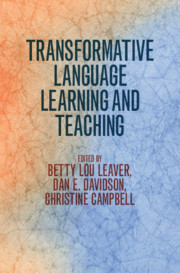Book contents
- Transformative Language Learning and Teaching
- Transformative Language Learning and Teaching
- Copyright page
- Contents
- Figures
- Tables
- Contributors
- Foreword
- Acknowledgments
- Abbreviations
- 1 Introduction
- Part I Theoretical Framework
- Part II Transformative Language Learning and Teaching Applications in Government Programs
- Part III Transformative Language Learning and Teaching Applications in University Programs
- Part IV Transformative Language Learning and Teaching Applications in Immersion Programs
- Part V The Learner
- Part VI Faculty Development
- Part VII Assessment
- 23 Identifying and Evaluating Transformative Learning in the Language Classroom
- 24 Testing and Transformative Language Learning
- 25 Assessing Students in a Transformative Learning Program
- References
- Index
24 - Testing and Transformative Language Learning
from Part VII - Assessment
Published online by Cambridge University Press: 26 January 2021
- Transformative Language Learning and Teaching
- Transformative Language Learning and Teaching
- Copyright page
- Contents
- Figures
- Tables
- Contributors
- Foreword
- Acknowledgments
- Abbreviations
- 1 Introduction
- Part I Theoretical Framework
- Part II Transformative Language Learning and Teaching Applications in Government Programs
- Part III Transformative Language Learning and Teaching Applications in University Programs
- Part IV Transformative Language Learning and Teaching Applications in Immersion Programs
- Part V The Learner
- Part VI Faculty Development
- Part VII Assessment
- 23 Identifying and Evaluating Transformative Learning in the Language Classroom
- 24 Testing and Transformative Language Learning
- 25 Assessing Students in a Transformative Learning Program
- References
- Index
Summary
This chapter considers evaluation of student learning in a transformative classroom as assessing the degree of personal development: direct application, to near transfer, to transfer. Concurrent with these stages are three levels of emotional experience: memorable (emotional without insight), meaningful (emotion with insight), and transformative (emotion with insight, reflection, and change in behavior or attitude). These experiences can be positive or negative, with negative experiences being often found to be more formative. Examples are provided for teaching and testing on the basis of the intersection of these three levels of instruction and three levels of experience from an understanding of achievement, performance, and proficiency tests, along with the impact of testing on instruction – examples of both positive and negative impact of testing are given, and the case is made for aligning testing format and content with desired learning outcomes. Finally, a systematic flaw, of which testing is a part, in instructional system design that impairs formative assessment is pointed out, and suggestions are provided for integrating assessment into TLLT.
Keywords
- Type
- Chapter
- Information
- Transformative Language Learning and Teaching , pp. 227 - 237Publisher: Cambridge University PressPrint publication year: 2021

